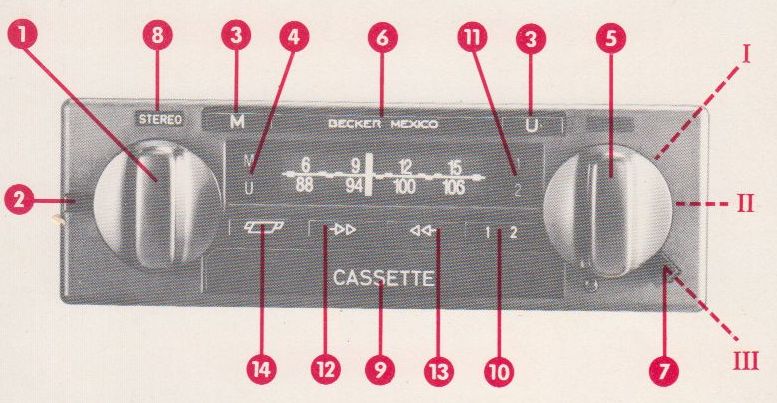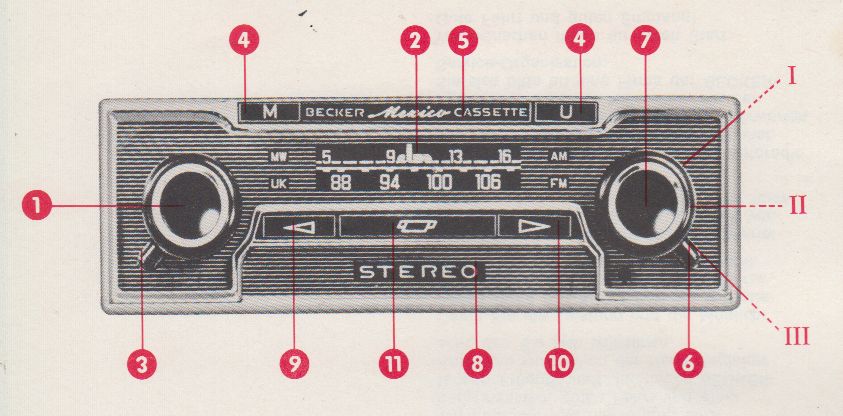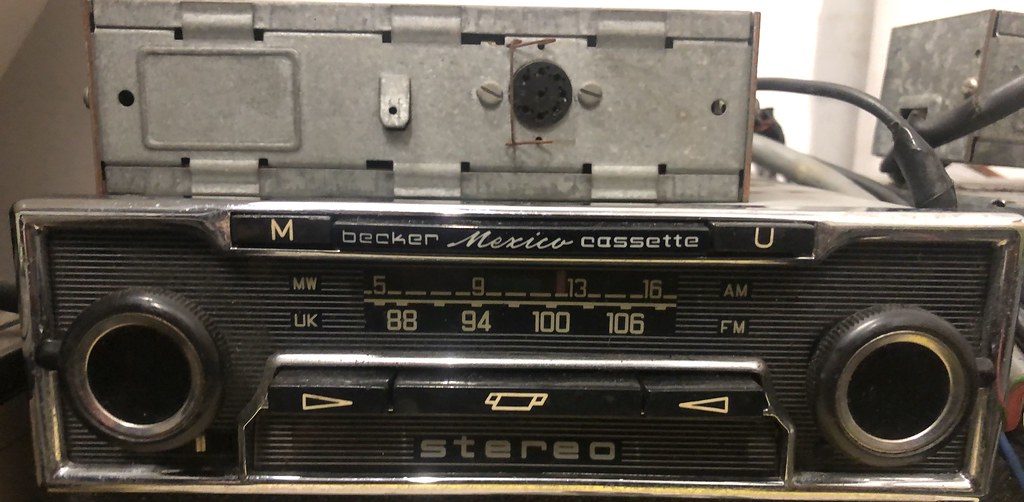The Becker 374 Mexico Cassette Vollstereo Reverse was the standard radio installed in the S-Class from 1979-1981 models in Australia. It was seen on the last of the W116s and I believe the early W126 too. This radio replaced the 485, the last of the pinstripe models in the W116s. It was the last of the older style radios with knobs to be found on the S-Class before the digital display radios were introduced.
The most significant difference between the Becker 374 and the similar looking Europa was the auto tune feature. This is commonly known as the ‘Wunderbar’. This version of the Mexico also features auto reverse, which the Europa did not get until later. The Europa was found in W123 models of the same era. My 1979 280SE is equipped with the Becker 374 Mexico. The Mexico was also a two piece unit with a separate amplifier.
Becker 374 Mexico Buttons

- On/Off Switch, Volume control
- Tone control
- Waveband push-buttons
- Waveband display
- Manual selector knob
- Automatic push-button
- Sensitivity switch
- Stereo indicator lamp
- Cassette slot
- Track change-over
- Track indicator
- Fast forward
- Fast reverse
- Cassette ejection
Becker 374 Mexico Radio Instructions
Switch on/off
Turn the left knob (1) to the right. The scale will illuminate.
Volume
To increase the volume, turn knob (1) further to the right.
Tone
The tone can be varied infinitely by the stub lever (2) on the left knob. Lever up – high tone, lever down – deep tone.
Waveband setting
The desired waveband is set by pressing one of the waveband push-buttons (3). The waveband display (4) illuminates simultaneously – M for medium wave and U for ultra-high frequency.
Station choice
Stations in the set waveband can be chosen by turning the manual selector knob (5).
Automatic station selector
Press the automatic button (8) briefly. The pointer will traverse the scale from left to right, and will stop at a transmitting station. At the end of the scale the pointer will jump back to search the scale again.
Sensitivity switcher (7)
The stub lever (7) on the right knob is used to determine the number of stations which are automatically tuned:
I = Pointer stops at many stations even those received only weakly
II = Pointer stops only at stations from which medium-strong signals are received.
III = Pointer stops only at stations giving strong signals.
Stereo Indicator lamp (8)
The stereo indicator lamp (8) illuminates when a chosen station is transmitting stereo signals. Note! Perfect stereo reception is possible only in areas with sufficiently powerful transmitters. The unit is thus fitted with a continuous mono/stereo change-over, i.e. when the received signal weakens, the equipment switches automatically to mono reception. The stereo indicator lamp continues to light up however and extinguishes only when the station can no longer be received satisfactorily.
Becker 374 Mexico Cassette functions
With the Reverse cassette section of the MEXICO CASSETTE VOLLSTEREO the cassettes need no longer be turned over at the end of the tape – i.e. on reaching the end of the first side the unit switches automatically to the second track.
Tape Playing
Insert the cassette into the cassette slot (9) and push in up to the stop. Switching from radio to tape is automatic.
Track indicator (11)
The track indicator shows which track is being played now.
Track change-over
By pressing the track change-over button briefly the opposite track can be played. At the end of the tape the change-over is automatic (continuous operation).
Fast forward (12) and fast reverse (13)
By pressing the forward (12) or reverse (13) buttons the tape is advanced or rewound quickly to choose other pieces of music. A brief press on the opposite button stops this winding process.
Cassette ejection
The operation of the ejection button (14) ejects the cassette from the cassette slot, and the unit switches automatically to radio reception.
We recommend:
Only use branded cassettes C60 and C90. Chromiumdioxide and Ferrochromium cassettes can be played without damaging the tape unit.
Through vehicle vibrations the tape roll in cassettes can shake loose. It is thus advisable to store cassettes in commercially available cassette boxes with tape spool locks, where they are also protected from dust. If despite this the spool has loosened or a loop has developed in the tape, rewind the tape by turning one of the spools with the point of a pencil. To prevent distortion of cassettes, protect them from direct sunlight or excessive heat.
Care and maintenance:
By cassettes the quality of reproduction gradually diminishes as deposits on the playing head are unavoidable. The playing head should thus be cleaned from time to time by using a cleaning cassette (available at your specialists). Be sure to pay close attention to the instructions included with the cleaning cassette! After about 1,000 hours of operation the equipment should be serviced by a service expert.
Connection of accessories
Possibilities here are automatic antenna, short-wave adaptor, traffic waveband adaptor, and EIC adaptor (interference suppression).
Fade-over control
When additional loudspeakers are installed at the rear of the vehicle the sound distribution can be varied between front and rear speakers by the fade over control.
Antenna trimmer:
After installation the antenna trimmer must be adjusted for optimum medium wave reception. Therefore select a weak station in the medium waveband at about 1500kHz. Insert a suitable screwdriver in the opening in the front panel below the manual selector knob and by turning lightly adjust the antenna trimmer to the maximum volume.
Becker 374 Mexico Technical Data
Radio Section:
Semi-conductors: 33 transistors, 38 diodes, 5 ICs
AM-circuits: 3x RF (variable), 7x IF
FM-circuits: 3x RF (variable), 12x IF
Wave ranges: (AM) M 510-1630kHz, (FM) U 87.5-108MHz (stereo)
Station choice: Automatic selector, Manual selector
Stereo-decoder: PLL-switch decoder with continuous mono/stereo change-over
Intermediate frequency: AM 460kHz, FM 10.7Mhz
Fading control: effective for 2 stages
Limitation: 2 diodes
FM: Automatic frequency control (AFC)
Tone control: Continuous with intermediate lever
Output voltage: 2x5W with 2 loudspeakers, 2x7W with 4 loudspeakers
Loudspeaker Impedance: 5 Ohm
Possible connections: Automatic antenna, EIC-adaptor, SW-adaptor
Operating voltage: 12V minus to mass
Current consumption: 0.36-1.3A depending on modulation
Fuse: 5 AT
Dimensions: Radio 185 x 52 x 167 mm, NF-part 147 x 42 x 55 mm
Cassette section:
Tone carrier: Compact cassette C60, C90
Tape speed: 4.76 cm/sec.
Operating method: Stereo reproduction, automatic reverse with track indicator.
Motor: Electronically regulated direct-current motor
Cassette ejection: by pushing the ejector button, automatically when power supply is interrupted
Track change over: By pressing the track change over button automatically at tape end
Change-over radio/cassette: Automatically when cassette is inserted and ejected. Automatically at radio information if VK-5 is connected.







[…] is two piece radio with a 2x7W amplifier. At least in Australia, it was superseded by the Becker Mexico Cassette 374 […]